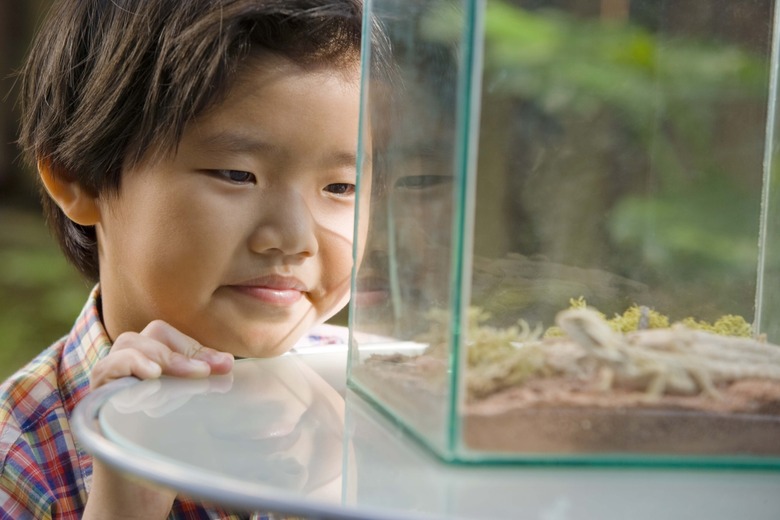How To Maintain A Singaporean Turtle
A Singaporean turtle, more commonly called a red-eared slider, is a popular option for a pet. They are semiaquatic, freshwater turtles that stay reasonably small. However, they do require regular care, and unfortunately, many red-eared sliders are released into the wild when their owners are unable to care for them. Before bringing this turtle into your home, make sure you have the time and resources to offer him the needed care.
Singaporean turtle habitat
Singaporean turtle habitat
Red-eared sliders need a large aquarium with both water and land. The minimum aquarium size is 30 to 50 gallons, but larger turtles may need more space. Make sure the tank is at least five times as long as your turtle and at least twice as deep as your turtle is long. Keep in mind that if you get a young turtle, she will grow quickly, so it is best to get a larger tank. If you get multiple turtles, you will need to double the tank size.
While most of the tank will be filled with water, your turtle also needs a platform where she can get out of the water to bask and ideally walk around. At least part of this land area should be stone, which absorbs heat for your turtle to bask. Make sure there is a slope leading up to the basking area so your turtle can easily transition between water and land.
Install a good filter in the tank but remember that even with the best filtration, you will need to clean the tank regularly. Plan on cleaning the tank about once per week. A dirty tank increases the chance of infection and illness. Enrich her habitat with plants, rocks, and wood. This not only makes it look more attractive but it offers hiding places and stimulation for your turtle.
Light and temperature
Light and temperature
Red-eared sliders need warm temperatures to stay healthy. Make sure your tank has a working heater and thermometer to monitor water temperature. The water should be kept between 75 and 86 degrees Fahrenheit. Don't return your turtle to the tank after cleaning until the water is warm enough.
In addition, you will need a heating lamp above the basking area. You will also need to monitor this temperature regularly and keep it between 85 and 88 degrees. Cold temperatures can lead to illness. A turtle also needs UVB light daily. If your turtle does not have access to the sun, he will need a UVB light in his tank. Check the label carefully, as these lights often need to be replaced every six months.
Feeding your Singaporean turtle
Feeding your Singaporean turtle
Red-eared sliders are omnivores. You can feed adult turtles every two days, but young turtles need to be fed daily. They need a varied diet to meet all their nutritional needs. You can feed your turtle 40 percent animal protein and 60 percent plant foods. Alternatively, you can add a commercial turtle food to her diet to help ensure she gets all the nutrition she needs.
In this case, feed her 25 percent commercial food, 25 percent animal protein, and 50 percent plant foods. Earthworms and feeder fish are ideal sources of animal protein. Good plant foods to offer include leafy greens, green beans, and squash.
Common health concerns
Common health concerns
Monitor your turtle for any signs of illness. It is normal for your turtle to shed his skin or shell, but if the shedding leaves behind raw or bleeding skin, it is more likely a bacterial or fungal infection. Calcium deficiency caused by insufficient UVB lighting can cause abnormal shell growth. Some turtles may also suffer from prolapse, which is life-threatening. This occurs when one of the internal organs, such as the intestines or bladder, emerge from the turtle's vent.
If you see any of these symptoms or other signs of illness, such as lethargy or loss of appetite, take your turtle to the vet right away. Your vet can diagnose the problem, offer treatment, and help to modify his diet and habitat to prevent future problems.
Lifetime of care
Lifetime of care
Red-eared sliders have a life span of 30 years or more. This is a big commitment, especially if you start with a baby turtle. Remember that in many locations, red-eared sliders are considered to be an invasive species, so you cannot simply release your pet turtle into the wild if you find she needs too much care.
References
- Mesa Veterinary Hospital: Care of Red-Eared Sliders
- ReptiFiles: Creating a Basking Area for Your Red-Eared Slider
- ReptiFiles: Red-Eared Slider Turtle Tank Décor Ideas
- Pet Keen: How to Take Care of a Red-Eared Slider (Care Sheet & Guide 2021)
- Oregon Department of Fish and Wildlife: Invasive Species Fact Sheet, Red-Eared Slider
